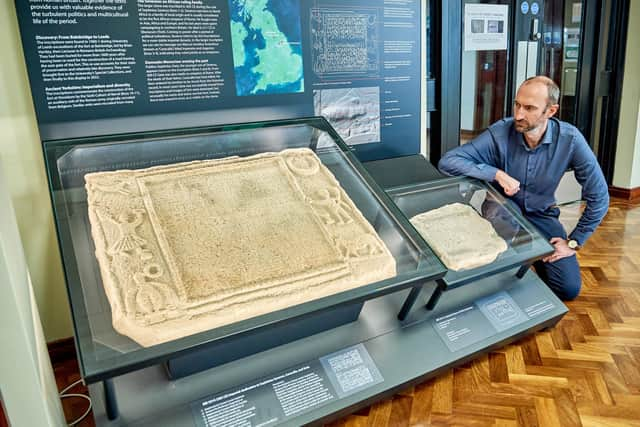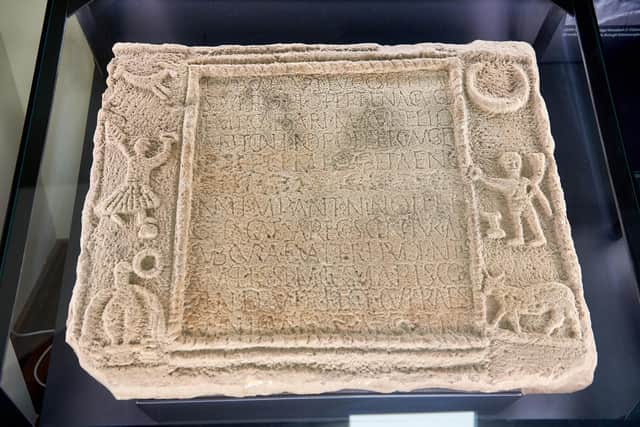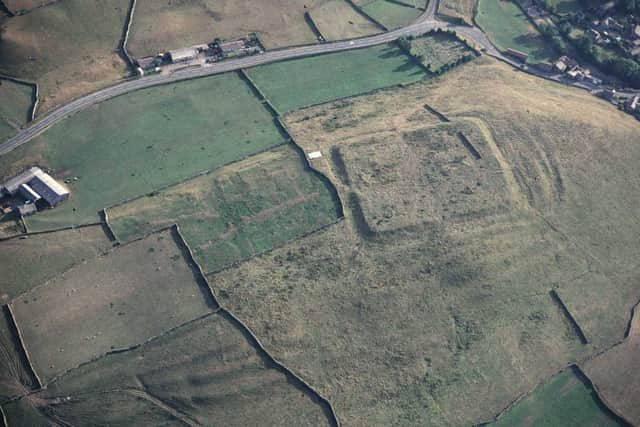From Rome to Yorkshire: Words of ancient Britain unveiled in Leeds
and live on Freeview channel 276
The stone bearing the ancient words was unearthed at Bainbridge in Wensleydale in 1960 by a team from the University but it was so heavy that it had to be housed in a basement on campus.
Now, more than four decades after it was discovered, it has been taken out of storage and is on display in the Michael Sadler building.
Advertisement
Hide AdAdvertisement
Hide AdThere are two pieces of Dales sandstone, which record the Roman army’s construction of buildings at a fort on Brough Hill in Bainbridge at the beginning of the 3rd century AD.


The larger of the two tells the story of a diverse and multicultural Britain and includes the names of several high-profile African rulers of Rome and Britain.
Dr Samuel Gartland, a lecturer in Leeds’ School of Languages, Cultures and Societies , led the resiting of the stones, one of which weighs 600lbs. A special crane had to be brought in to shift it into its new position.
“The larger stone really is a superstar inscription, one of the longest and largest ever to be found in ancient Britain and unlikely to ever be surpassed as a record of the world of Roman Yorkshire,” he said. “Appropriately enough for our launch during Black History month, the stones tell of a period where Yorkshire came under the rule of the first African emperors of Rome, as well as the dynastic jostling and assassinations in the imperial family.”
Advertisement
Hide AdAdvertisement
Hide AdThe stones were initially built into the wall of a barracks building but they had subsequently been reused as foundations for a Roman road and spent much of the past two millennia upside down in a muddy field.


The archaeologists who discovered them knew they had found something special, with the writing and images miraculously well-preserved, but moving the objects was a weighty problem and the Royal Engineers army regiment at York were eventually called in to relocate them from Bainbridge to the
University.
The inscription is already attracting a great deal of interest in academic circles, including an expert from the University of Glasgow who intends to scan the stone with specialist laser equipment to try to capture its original colours.
Luke Bassnett Barker, countryside archaeological advisor at the Yorkshire Dales National Park Authority, said: “‘We are very excited about Leeds University displaying this inscribed stone and we hope that this helps to draw others to explore the historic environment of the Yorkshire Dales National Park."


Advertisement
Hide AdAdvertisement
Hide AdHe added: “The authority manages the Historic Environment Record for the area, which consists of tens of thousands of records of monuments, archaeological finds and historic structures reflecting human occupation and interaction with the landscape through time. Researchers need only get in touch to gain access to information on what remains a wonderful, yet underused, resource.”
The stones will be unveiled to the public at 5.30pm today (October 18) after which there will be a talk celebrating the discovery of the inscriptions and exploring their significance.
